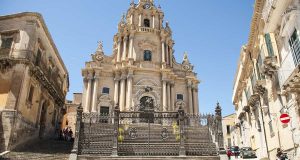The San Vincenzo Ferreri Auditorium is housed in a former church located inside the Hyblaean Garden. Originally built in 1509, it was renovated and modified after being damaged in the 1693 earthquake. After its restoration, the church is used to host cultural events such as musical performances and public lectures.
History of the ancient church of San Vincenzo Ferreri
The original construction of the Church of San Vincenzo Ferreri dates back to 1509. After being damaged by the earthquake of 1693, the building was consolidated and an oratory was added as the headquarters of the Dominican Fraternity. The latter was later demolished to create the internal avenue of the hyperboloid garden that connects the Auditorium to the Church of San Giacomo. The interior of the church was decorated in Baroque style and in 1718 the bell tower was rebuilt. During the 20th century the church underwent several changes and was then completely abandoned. Restoration work began in 2004 and was completed in 2010. The building has been transformed into the San Vincenzo Ferreri Auditorium. It has 140 seats and is regularly used for cultural events such as musical performances and public lectures
Interesting fact: The Auditorium San Vincenzo Ferreri is one of the locations of Commissario Montalbano. It can be seen in the episode “Love”, when a pair of elderly actors perform “Romeo and Juliet”.
Architecture and works of art of the Auditorium San Vincenzo Ferreri
The façade of the former church of San Vincenzo Ferreri is very simple, although it is embellished by a sundial in the right corner. The bell tower has a dome with an unusual pagoda shape and is covered with polychrome marble. The interior of the church has a single nave and a characteristic black and white rhomboid floor. Between 1731 and 1734, Onofrio Russo, a pupil of Giacomo Serpotta, made all the stucco decorations inside the church. He is responsible for the splendid twisted columns on the side walls and the decorations on the high altar.
Aggiungi ai preferiti






























